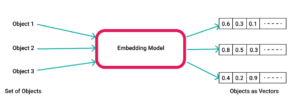Real-time analytics have solidified their position as a cornerstone across numerous industries. Separately, the allure of generative AI has captured widespread attention, promising innovative solutions and unprecedented insights in fields ranging from entertainment to healthcare. The convergence of real-time analytics using generative AI methods presents a compelling synergy. It equips organizations to uncover deeply hidden insights in cases when the opportunity is perishable.
DJ Patil, former Chief Data Scientist of the United States, and former Chief Scientist at LinkedIn, says that fully harnessing the potential of generative AI will necessitate the development of capabilities focused on rapid data processing.
“Most of the stuff we see around LLMs today is low-speed data; it’s very static, and it hasn’t been updated,” Patil says. “That’s something I think we’re going to see develop over the next 24 months.”
One of the revolutionary technologies at the heart of generative AI are vector databases. Think of these as organized collections of information that take pattern matching to new heights. A vector embedding is a way of organizing data that makes it easier to find similarities and relationships between different pieces of data. So far, vector databases have been limited by stale, historical data. Users of ChatGPT are familiar with the fact that it is blind to any information created after September 2021.
In order to fully appreciate the immense potential of real-time generative AI, it requires that we shift our perspective away from the myopic notion that generative AI is confined to creative domains like music, visual arts, and prose. While these artistic applications have undoubtedly showcased the technology’s capabilities, the scope of generative AI extends far beyond these realms. It holds the power to optimize various sectors where fast-moving data from sensors and machines are critical for decision-making.
How will it change the way businesses operate? In financial services, I think we’ll see real-time vector search revolutionize fraud detection and risk assessment. By encoding historical transaction data and customer profiles as vectors, you could rapidly match incoming transactions against known patterns of fraudulent behavior. This would enable instant identification of suspicious activities, leading to quicker response times and reduced financial losses.
Additionally, risk assessment models will leverage real-time vector embeddings to provide up-to-the-moment evaluations of market conditions, optimizing investment decisions. For example, consider investment banking’s use of VWAP, short for volume-weighted average price, which serves as a technical analysis instrument revealing the relationship between an asset’s price and its total trade volume. It offers traders and investors a means to assess the average price at which a stock has been traded during a specified time frame.
Think of VWAP as a potential vector embedding, of which there is one for each stock, across each trading desk, across multiple windows in time, resulting in thousands of vector embeddings created each day. Now consider that VWAP is but one of dozens of financial metrics used to make a buy or sell determination in real-time, necessitating more vector embeddings. If every stock maintained numerous regularly updated vector embeddings to reflect market conditions, it would unveil unprecedented patterns and opportunities in the financial landscape. For instance, “show me the top three stocks poised to break out to the upside in the next five days.”
Logistics is another area ripe for change by coupling generative AI with the wealth of sensor readings from vehicles, containers, warehouses, conveyor systems, packaging, and more. Through ongoing analysis in dynamic conditions, businesses can optimize route planning, reduce delivery times, minimize spoilage, and lower inventory holding costs. It won’t only streamline logistics but will also equip organizations with the agility required to respond promptly to unforeseen disruptions.
Real-time vector search holds immense potential in defense applications, particularly for threat hunting and intelligence analysis. In this context, vector embeddings could represent features such as radar signatures, satellite imagery, or intercepted communication patterns. Real-time vector search systems will swiftly compare incoming data to a comprehensive database of known threats and anomalies. This will enable military and security personnel to rapidly identify potential threats, such as new aerial spy vehicles or suspicious troop movements and make informed decisions accordingly.
Any industry that is already benefiting from real-time analytics will find this breakthrough in pattern matching will take existing use cases to the next level. In retail, it will make recommender systems more accurate by matching customer preferences to available products. In the automotive sector, it will enhance advanced driver assistance systems through real-time recognition of objects and road conditions. In manufacturing, it will optimize quality control by rapidly identifying defects in production lines. In the energy sector, it will streamline grid management and predictive maintenance for improved efficiency. In utilities, it will bolster infrastructure monitoring, reducing downtime and ensuring reliable service delivery.
To support these use cases, the key technology shift is from batch-oriented vector databases to real-time vector databases. We’re seeing innovations like NVIDIA’s framework for GPU vector search that is paving the way for real-time insights based on vector embeddings.
About the author: Chad Meley is the Chief Marketing Officer for Kinetica, a provider of GPU-accelerated analytics solutions. Chad’s has more than 20 years of experience as a leader in SaaS, big data, advanced analytics, where he has provided data-driven marketing, strategy and planning for early-stage software companies and large, established leaders alike. Prior to joining Kinetica, Chad was VP of Product Marketing at Teradata. Chad has also held a variety of leadership roles centered on data and analytics with Electronic Arts, Dell and FedEx. Chad holds a doctorate from the University of Florida where his dissertation was on Applied Artificial Intelligence, an MBA from the Rawls College of Business at Texas Tech University and a B.A. in Economics from the University of Texas.
provider of GPU-accelerated analytics solutions. Chad’s has more than 20 years of experience as a leader in SaaS, big data, advanced analytics, where he has provided data-driven marketing, strategy and planning for early-stage software companies and large, established leaders alike. Prior to joining Kinetica, Chad was VP of Product Marketing at Teradata. Chad has also held a variety of leadership roles centered on data and analytics with Electronic Arts, Dell and FedEx. Chad holds a doctorate from the University of Florida where his dissertation was on Applied Artificial Intelligence, an MBA from the Rawls College of Business at Texas Tech University and a B.A. in Economics from the University of Texas.
Related Items:
Retool’s State of AI Report Highlights the Rise of Vector Databases
Vector Databases Emerge to Fill Critical Role in AI
The post How Real-Time Vector Search Can Be a Game-Changer Across Industries appeared first on Datanami.



0 Commentaires